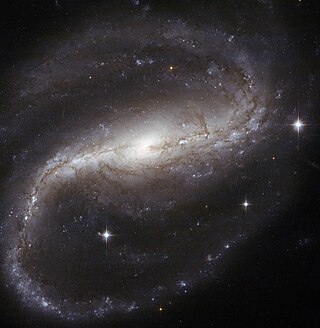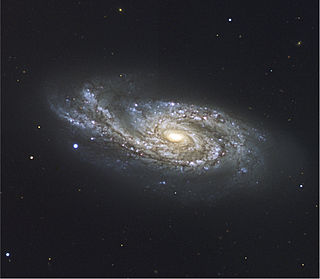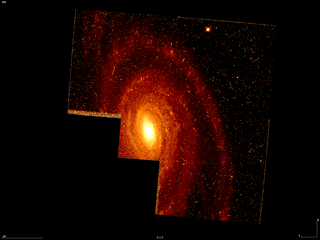
Messier 83 or M83, also known as the Southern Pinwheel Galaxy and NGC 5236, is a barred spiral galaxy approximately 15 million light-years away in the constellation borders of Hydra and Centaurus. Nicolas-Louis de Lacaille discovered M83 on 17 February 1752 at the Cape of Good Hope. Charles Messier added it to his catalogue of nebulous objects in March 1781.

Messier 108 is a barred spiral galaxy about 28 million light-years away from Earth in the northern constellation Ursa Major. It was discovered by Pierre Méchain in 1781 or 1782. From the Earth, this galaxy is seen almost edge-on.

NGC 4945 (also known as Caldwell 83) is a barred spiral galaxy in the constellation Centaurus, visible near the star Xi Centauri. The galaxy was discovered by James Dunlop in 1826 and is thought to be similar to the Milky Way Galaxy, although X-ray observations show that NGC 4945 has an unusual energetic Seyfert 2 nucleus that might house a supermassive black hole. Around the nucleus of the galaxy, there is a dense disk of dust and gas, along with many dense star clusters. This object has an estimated mass of 1.4+1.4
−0.7×1011 M☉.

NGC 7479 is a barred spiral galaxy about 105 million light-years away in the constellation Pegasus. William Herschel discovered it in 1784. NGC 7479 is also recognized as a Seyfert galaxy and a LINER undergoing starburst activity not only on the nucleus and the outer arms, but also across the bar of the galaxy, where most of the stars were formed in the last 100 million years. Polarization studies of this galaxy indicate that it recently underwent a minor merger and that it is unique in the radio continuum, with arms opening in a direction opposite to the optical arms. This feature, along with the asymmetrical arms of the galaxy and the intense star formation activity are attributed to a merger with a smaller galaxy. This galaxy is similar in both size and morphology to the barred spiral NGC 1300.

NGC 2207 and IC 2163 are a pair of colliding spiral galaxies about 80 million light-years away in the constellation Canis Major. Both galaxies were discovered by John Herschel in 1835.

NGC 1084 is an unbarred spiral galaxy in the constellation Eridanus. It is located at a distance of about 63 million light-years away from the Milky Way. The galaxy was discovered by William Herschel on 10 January 1785. It has multiple spiral arms, which are not well defined. It belongs in the same galaxy group with NGC 988, NGC 991, NGC 1022, NGC 1035, NGC 1042, NGC 1047, NGC 1052 and NGC 1110. This group is in turn associated with the Messier 77 group.

NGC 908 is an unbarred spiral galaxy in the constellation Cetus. It was discovered on 20 September 1786 by William Herschel. This galaxy is 56 million light years away from Earth. It is the main galaxy in the NGC 908 group, which also includes NGC 899, NGC 907, and IC 223.

NGC 1614 is the New General Catalogue identifier for a spiral galaxy in the equatorial constellation of Eridanus. It was discovered on December 29, 1885 by American astronomer Lewis Swift, who described it in a shorthand notation as: pretty faint, small, round, a little brighter middle. The nebula was then catalogued by Danish-Irish astronomer J. L. E. Drayer in 1888. When direct photography became available, it was noted that this galaxy displayed some conspicuous peculiarities. American astronomer Halton Arp included it in his 1966 Atlas of Peculiar Galaxies. In 1971, Swiss astronomer Fritz Zwicky described it as a "blue post-eruptive galaxy, compact patchy core, spiral plumes, long blue jet SSW".

NGC 7552 is a barred spiral galaxy in the constellation Grus. It is at a distance of roughly 60 million light years from Earth, which, given its apparent dimensions, means that NGC 7552 is about 75,000 light years across. It forms with three other spiral galaxies the Grus Quartet.

NGC 1964 is a barred spiral galaxy in the constellation Lepus. The galaxy lies 65 million light years away from Earth, which means, given its apparent dimensions, that NGC 1964 is approximately 100,000 light years across. At its center lies a supermassive black hole, with estimated mass 2.5 × 107M☉. The galaxy features two tightly wound inner spiral arms within a disk with high surface brightness and two outer, more open spiral arms that originate near the inner ring. The outer arms feature few small HII regions.

NGC 5861 is an intermediate spiral galaxy in constellation Libra. It is located at a distance of about 85 million light years from Earth, which, given its apparent dimensions, means that NGC 5861 is about 80,000 light years across.

NGC 4699 is an intermediate spiral galaxy located in the constellation Virgo. It is located at a distance of about 65 million light years from Earth, which, given its apparent dimensions, means that NGC 4699 is about 85,000 light years across. It was discovered by William Herschel in 1786. It is a member of the NGC 4699 Group of galaxies, which is a member of the Virgo II Groups, a series of galaxies and galaxy clusters strung out from the southern edge of the Virgo Supercluster.

NGC 3631 is a spiral galaxy located in the constellation Ursa Major. It is located at a distance of about 35 million light years from Earth, which, given its apparent dimensions, means that NGC 3631 is about 60,000 light years across. It was discovered by William Herschel on April 14, 1789. It is a grand design spiral galaxy seen face on.

NGC 3810 is a spiral galaxy located in the constellation Leo. It is about 50 million light years from Earth, and estimated to be about 60,000 light years in diameter. William Herschel discovered it on 15 March 1784.

NGC 7469 is an intermediate spiral galaxy in the constellation of Pegasus. NGC 7469 is located about 200 million light-years away from Earth, which means, given its apparent dimensions, that NGC 7469 is approximately 90,000 light-years across. It was discovered by William Herschel on November 12, 1784.

NGC 3367 is a barred spiral galaxy located in the constellation Leo. It is located at a distance of about 120 million light years from Earth, which, given its apparent dimensions, means that NGC 3367 is about 85,000 light years across. It was discovered by William Herschel on March 19, 1784.

NGC 4939 is a spiral galaxy located in the constellation Virgo. It is located at a distance of about 120 million light years from Earth, which, given its apparent dimensions, means that NGC 4939 is about 190,000 light years across. It was discovered by William Herschel on March 25, 1786.

NGC 5965 is a spiral galaxy located in the constellation Draco. It is located at a distance of circa 150 million light years from Earth, which, given its apparent dimensions, means that NGC 5965 is about 260,000 light years across. It was discovered by William Herschel on May 5, 1788.

NGC 7130 is a spiral galaxy located in the constellation Piscis Austrinus. It is located at a distance of about 220 million light years from Earth, which, given its apparent dimensions, means that NGC 7130 is about 100,000 light years across. It was discovered by John Herschel on September 25, 1834, and discovered independently by Lewis Swift on September 17, 1897. The location of the galaxy given in the New General Catalogue was off by 30 arcminutes in declination from the location of the galaxy.

NGC 7418 is an intermediate spiral galaxy located in the constellation Grus. It is located at a distance of circa 60 million light-years from Earth, which, given its apparent dimensions, means that NGC 7418 is about 60,000 light-years across. It was discovered by John Herschel on August 30, 1834.






















